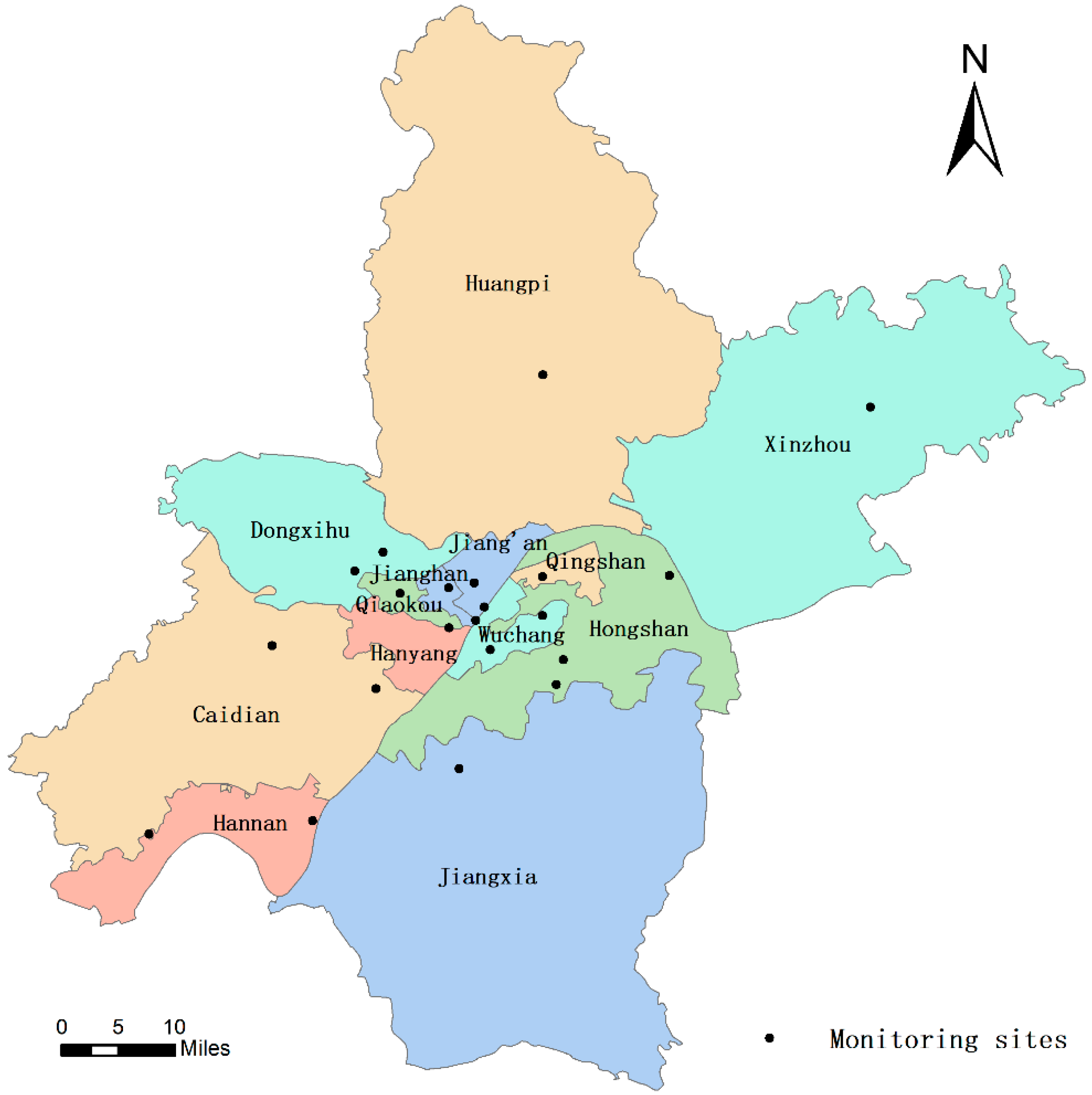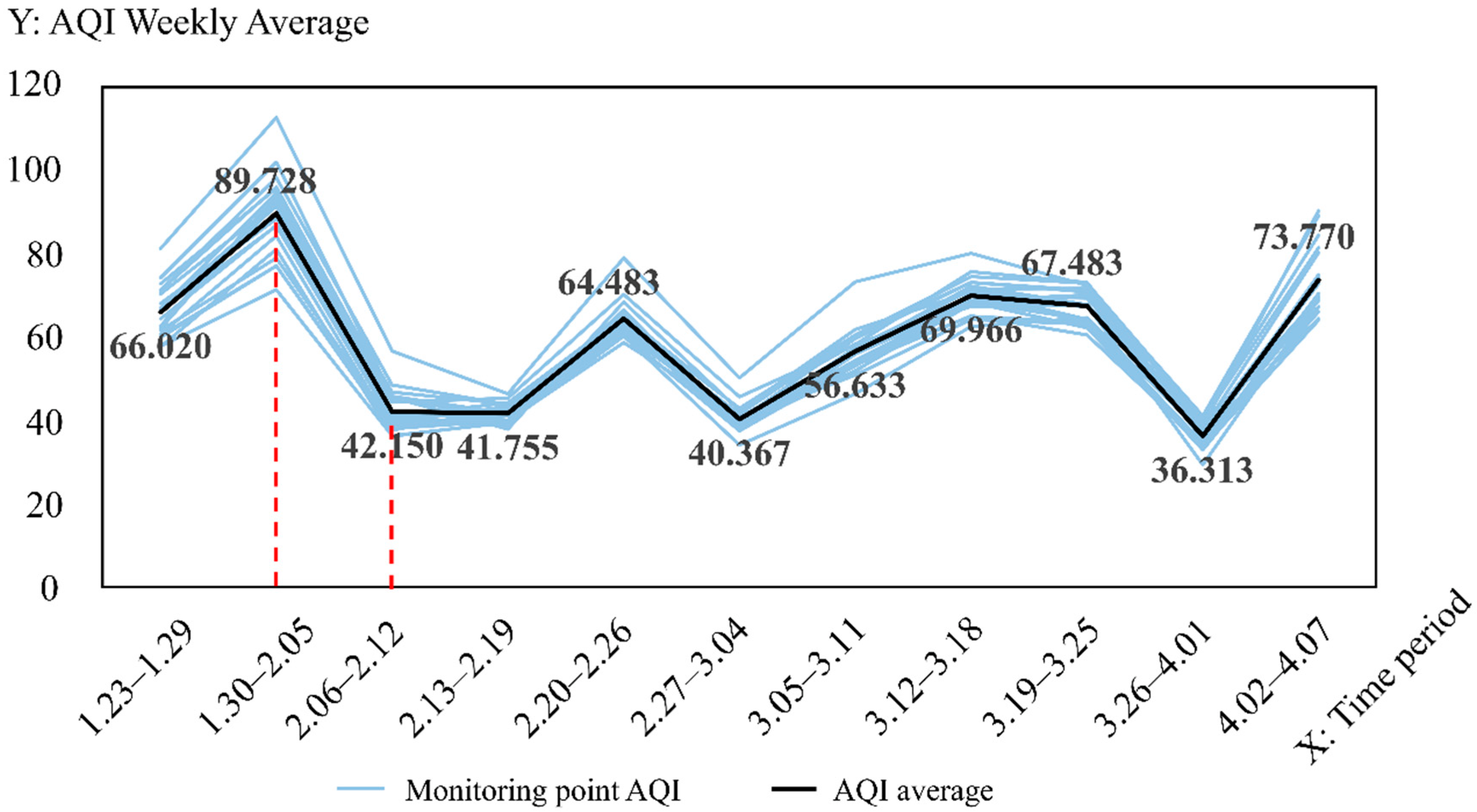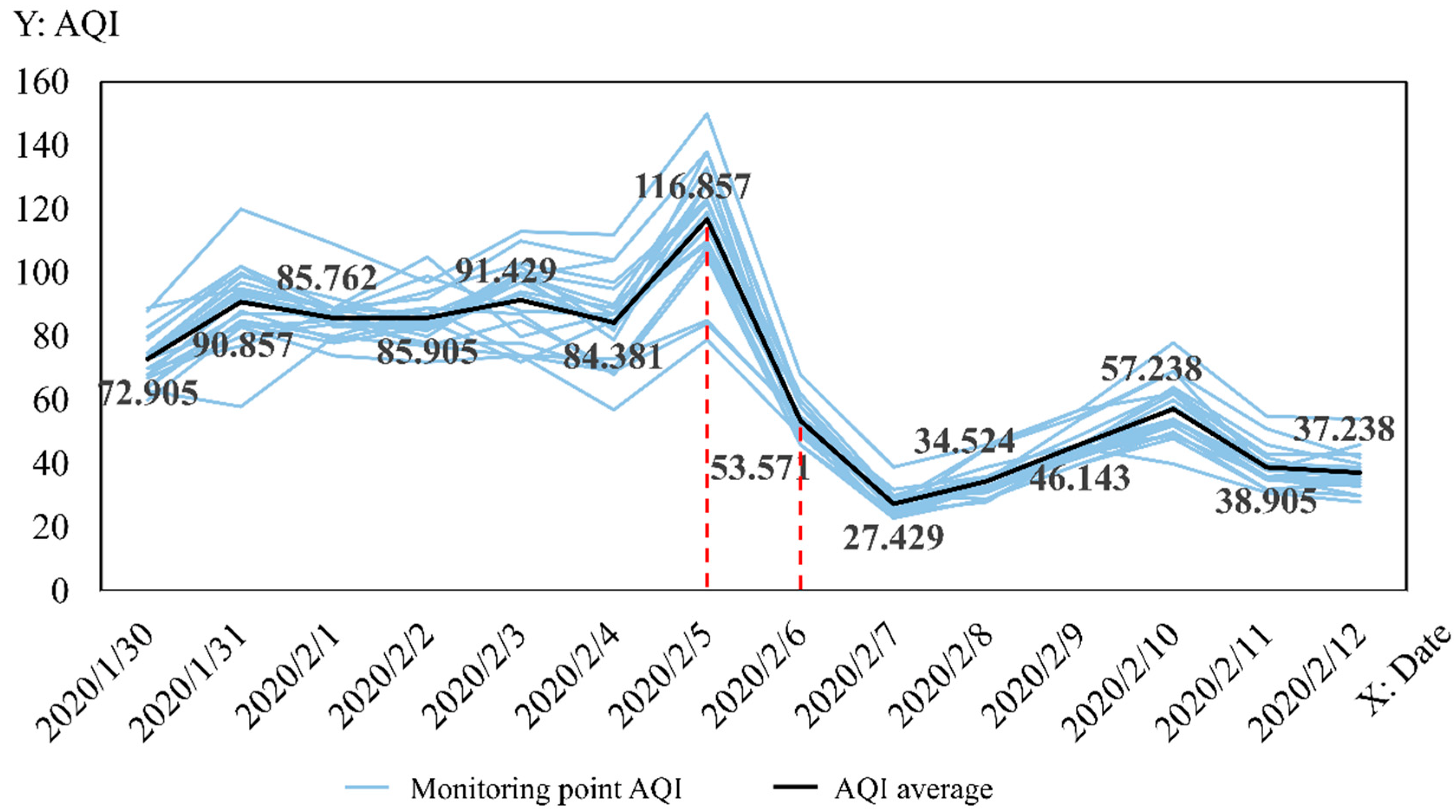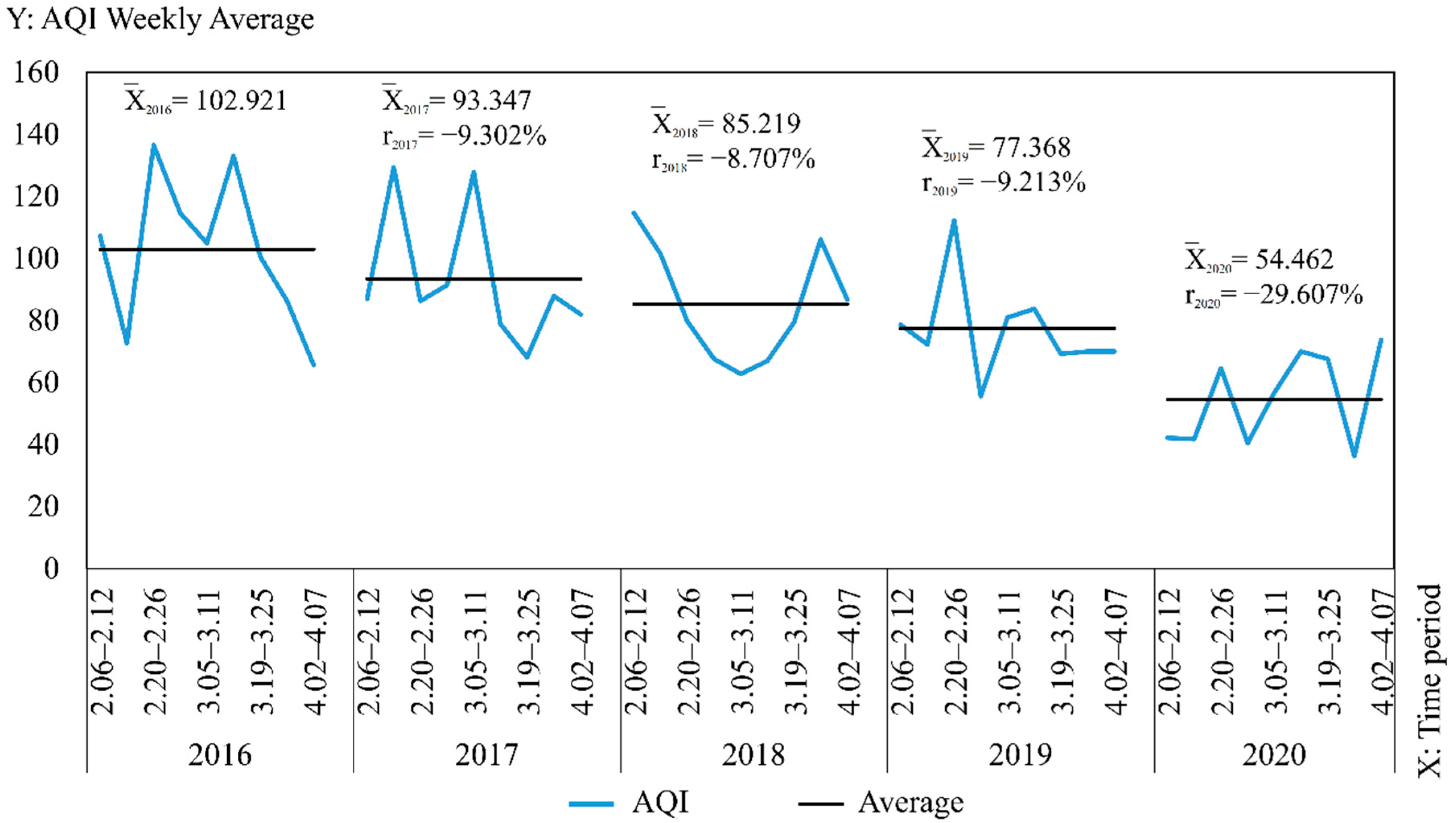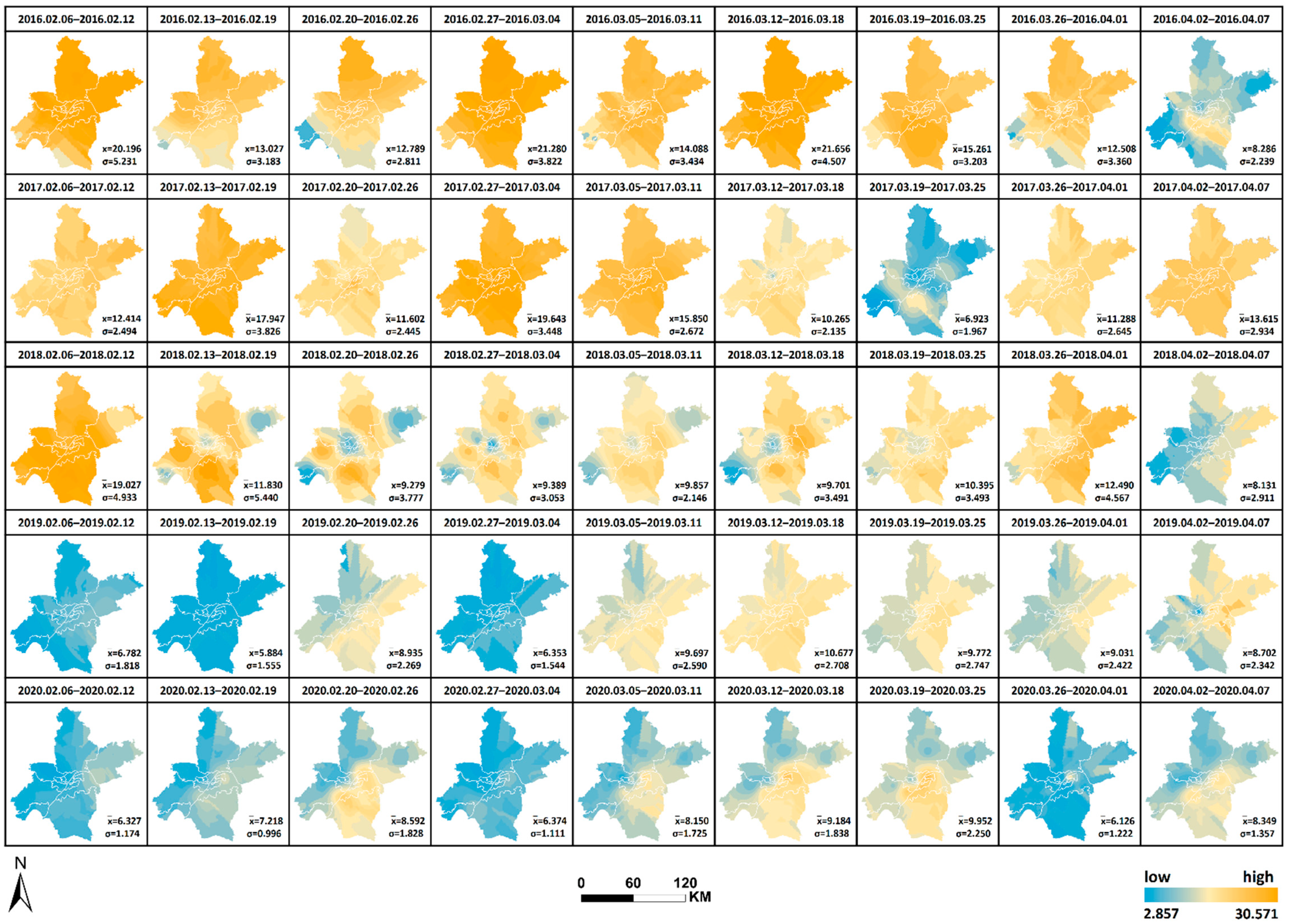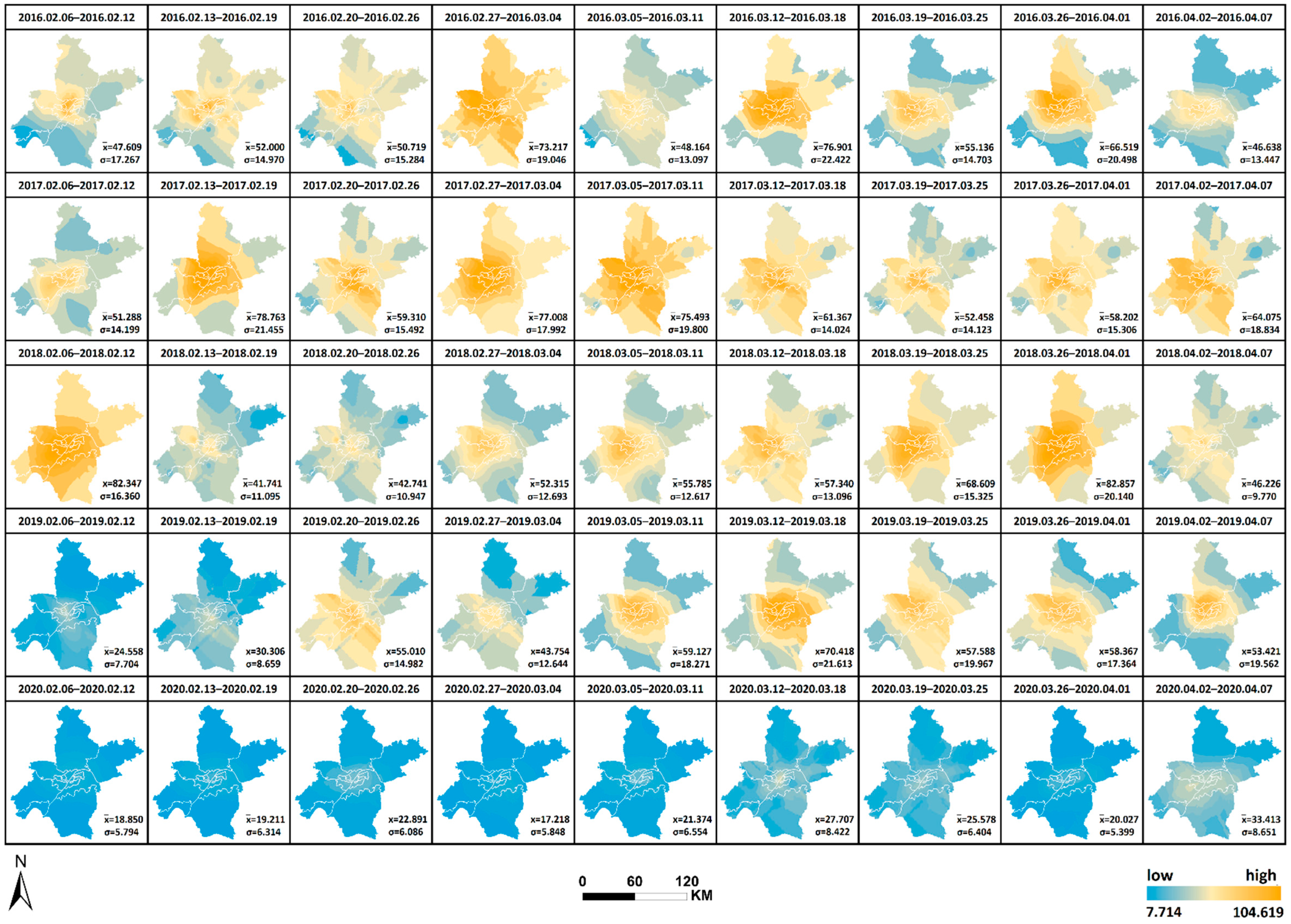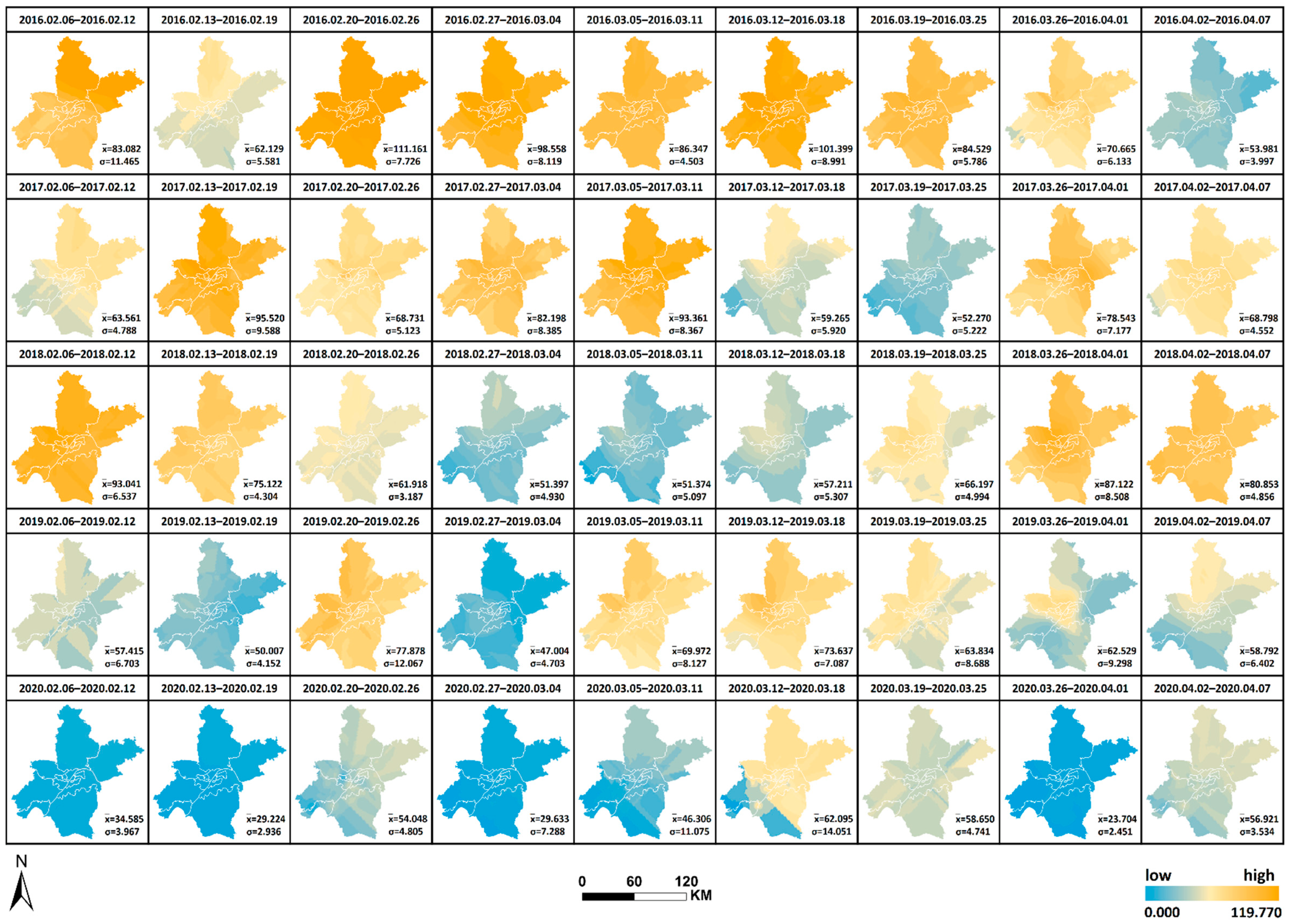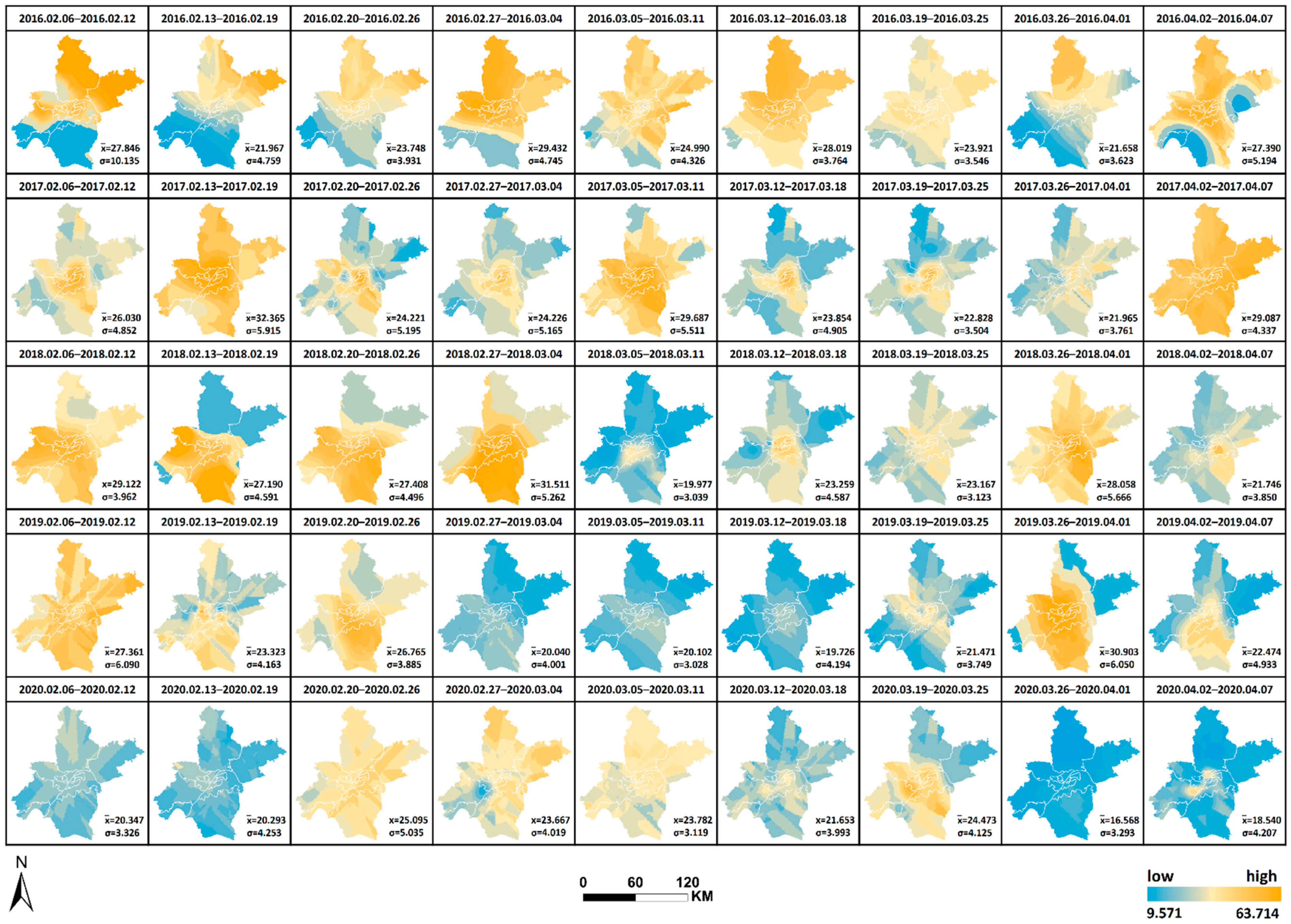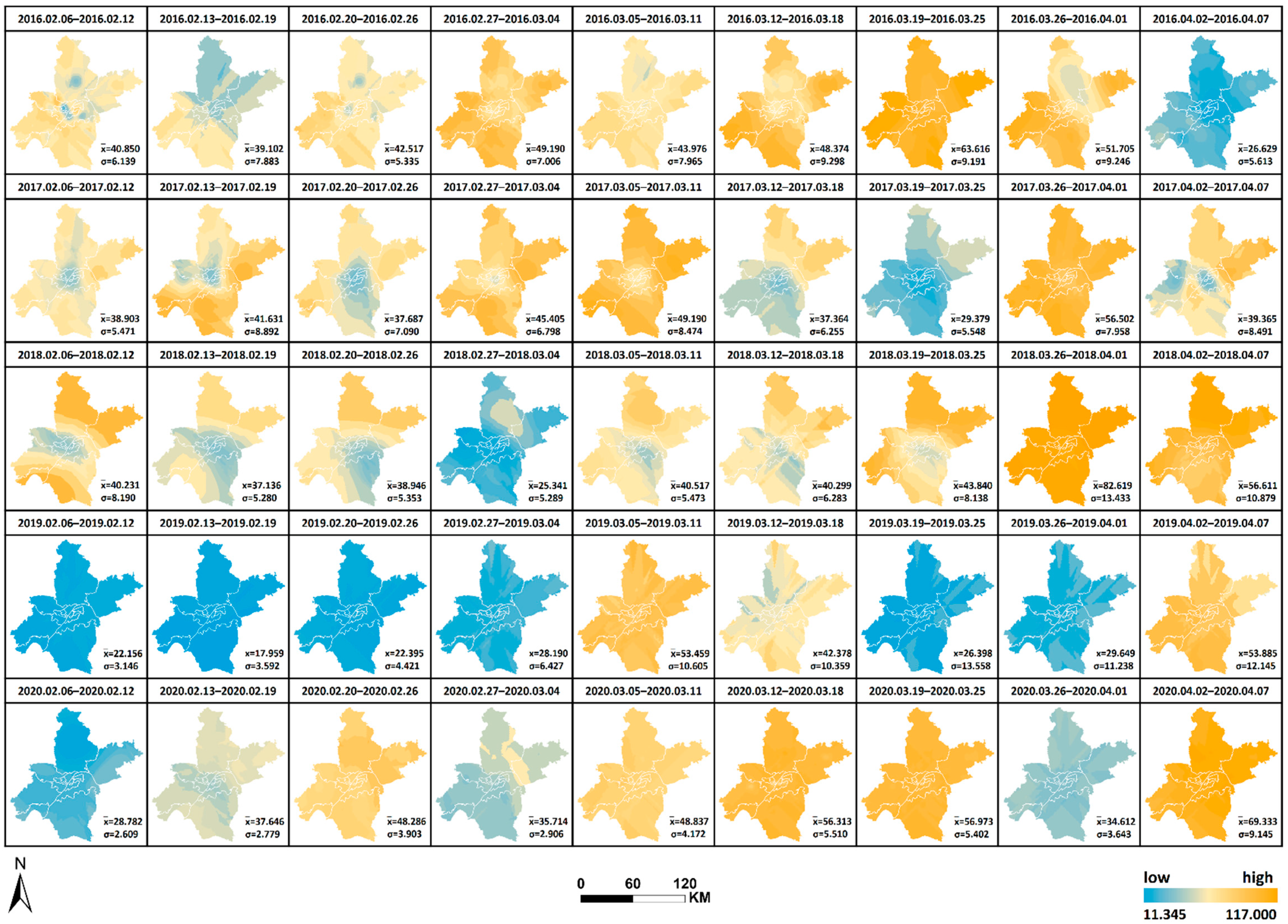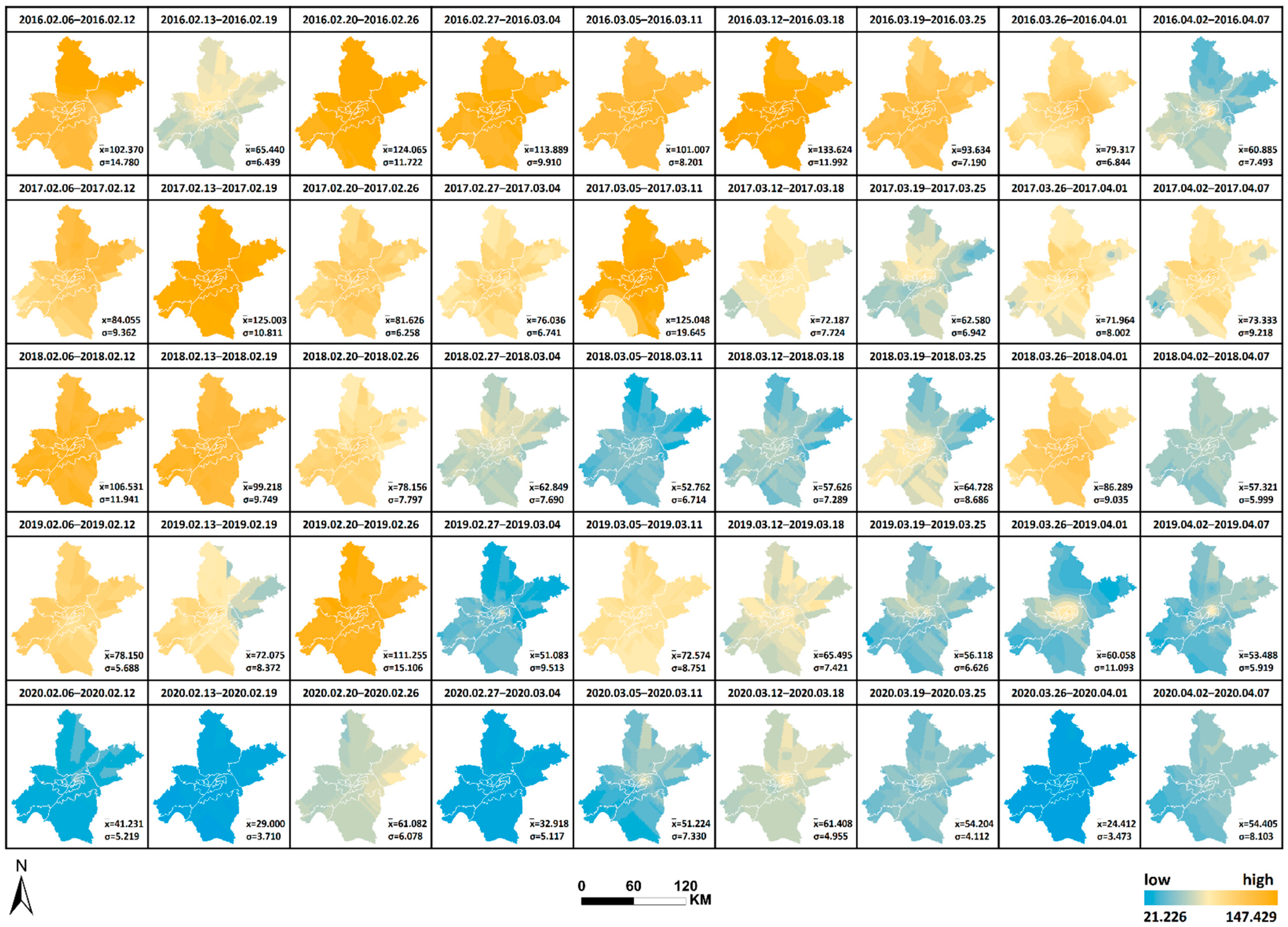1. Introduction
Over the past two years, Coronavirus Disease 2019 (COVID-19) pandemic has seen an increasing number of confirmed cases and deaths, resulting in incalculable loss of life and property. According to data from the World Health Organization on 29 June 2022 at 00:30 a.m. BST, the number of confirmed cases reached 542,188,789 and the number of confirmed deaths reached 6,329,275 worldwide [
1]. Many countries or regions have adopted strict pandemic prevention measures to prevent the further spread of COVID-19; amongst which, minimizing the movement of people has become an effective means of prevention. Strict closure measures have serious negative impacts on social and economic aspects worldwide [
2]. In the early stages of the pandemic, China experienced negative GDP growth of −6.8% year-on-year in the first quarter of 2020 [
3]. However, the blockade has a positive effect on air quality improvement [
4,
5,
6]. Wuhan is in central China, with a population of approximately 12.33 million [
7] in an area of 8569.15 km
2 [
8]. In China, COVID-19 first broke out in Wuhan. The city adopted the most stringent city-wide lockdown strategy during the initial phase of the outbreak: public transportation operations were halted from 10 a.m. on 23 January 2020 [
9]; streets, neighborhoods and villages were blocked; travel restrictions were imposed. These operations were lifted at 00 a.m. on 8 April, ending the city closure that lasted 76 days. All medical and household supplies were jointly distributed in Wuhan during this period [
10], all residents were isolated at home and human activities in the entire city came to a near standstill, demonstrating considerable sacrifices to prevent the spread of the virus. Wuhan, the first city in the world to adopt a city closure strategy, offers an opportunity to study the impact of human activities on the atmospheric environment.
In addition to Wuhan, many countries and regions also adopted city closure measures during the COVID-19 outbreak to interrupt the spread of the virus. For example, Italy, Germany, France, New Zealand, India, and other countries either completely banned the movement of people or restricted activities in some areas at different times. Several scholars have studied the changes in air quality in these cities during the blockade period, and most of these studies have shown that urban closure has a positive effect on air quality improvement. Bassani, Filonchyk, Shafeeque and Arshad et al. used satellite remote sensing imagery to investigate changes in air pollution during the blockade period in Rome (March–April 2020), Poland (March–April 2020) and the Indo-Pak region (March–June 2020) respectively. The studies found that (1) the closure measures significantly reduced NO
2 emissions from road traffic in Rome and surrounding areas and that the decrease was higher in urban than in rural areas [
4]; (2) the closure measures significantly improved air quality in Poland [
5]; (3) a significant decrease in air pollution could be observed across the Indo-Pak region during the blockade period [
2]. They concluded that strict closure measures contributed to the improvement of global environmental conditions [
6]. Malhotra and El-Sayed et al. studied the impact of the blockade on air quality in Delhi hot spots in India (March–April 2020) and six major cities in Florida (February–April 2020) through statistical analysis. They observed that reductions in pollutants PM
2.5, PM
10 and NO
2 in Delhi, India, were significantly associated with the city closure measures [
11], whilst NO
2 and CO levels in Florida were reduced during the blockade [
12]. Cui, Cao and Feng et al. studied the air quality in Dongying City, Shijiazhuang City and Xi’an City of China during and before and after the city closure. They found that (1) urban blockade had an improving effect on air quality in Dongying during the pandemic [
13]; (2) the blockade reduced the emission of pollution sources to a certain extent and the pollutant concentrations of PM
2.5, PM
10, NO
2, SO
2 and CO all decreased in Shijiazhuang [
14]; (3) NO
2 levels in Xi’an substantially decreased during the city closure [
15]. Tao et al. used a TVP-VAR model to analyze the dynamic relationship between pandemic, economy and air quality in Beijing from January to August 2020, showing the positive impact of the urban blockade on air management. However, this impact will gradually diminish as the blockade ends [
16].
However, a few research results prove that urban blockade does not possess a positive effect on air pollution improvement. Donzelli et al. evaluated the impact of pollutant emission reductions on air quality in three cities during the Italian city closure period (March–June 2020) [
17]. They concluded that evidence of a direct relationship between the implementation of closure measures and the reduction of particulate matter in urban centers (except in high traffic areas) is absent. However, they agreed that overall source control measures should be implemented to improve urban ambient air quality [
17]. In addition, studies by Cao and Feng et al. have found some negative effects of city closure, reflected in the increase in O
3 pollution [
14,
15].
The city of Wuhan is closed for two seasons, namely winter and spring, and the length of the blockade and the strict measures are unparalleled in many cities. Accordingly, systematically examining the effects of closure measures on air quality in Wuhan is particularly necessary. Seasonal factors are also an important factor affecting AQI [
18,
19]. In addition, air quality change due to the city closure is a slow process with a lag effect, which is not addressed in the existing relevant studies. The above lag effect and seasonal factors will be considered in this paper, and five years of air quality data of Wuhan city from 2016 to 2020 are selected to analyze the air quality lag effect and spatial and temporal divergence characteristics during the blockade of Wuhan city for quantifying the extent of human activities on urban air quality.
4. Discussion
We compared the air quality data for the five years from 2016 to 2020 and found that overall air quality conditions in Wuhan substantially improved impacted by city closure. This study could be further discussed in the following areas.
We started this study at the beginning of 2021, so the deadline for collecting data was the end of 2020. Theoretically, the richer the data from different years, the more comparative value it has. In China, every five years, the government will make a development plan, and it is reasonable to take a five-year cycle to observe the development of a city in China and its resulting changes in air quality. Therefore, we chose to collect data for the period 2016–2020 for our study. Missing air quality monitoring data is inevitable. Various methods have been proposed to fill in these missing data, such as mean filling, the regression analysis method, EM filling algorithm, multiple interpolation, KNN-DBSCAN algorithm, NN-DSAE algorithm, GRU, etc. [
36,
37,
38,
39]. The arithmetical series formula is relatively simple and commonly used methods. The missing data in this paper are less than 3% of the total data, and it remains to be verified whether the use of different methods will have an influence on the results of the study.
Xu et al. tested the lagged correlation of AQI on confirmed COVID-19 cases by lagged models [
40]. Ma et al. applied the distributed lag nonlinear model and generalized summation model to calculate the lag effect of AQI on the number of respiratory emergencies [
41]. Bao et al. used a Poisson regression model combined with the distributed lag nonlinear model to study the lag effect of air pollution on population mortality [
42]. However, studies analyzing the lag effect of urban blockade on AQI are relatively few. There are various methods for lag effects analysis, such as DLNM and lagged variable model [
43,
44]. In this study, the mutation test was used. At present, the Pettitt mutation test has been applied very little to air quality. Shi made the mutation point analysis of PM2.5 concentration time series with the help of MK mutation test and Pettitt mutation test [
45]. Luo et al. suggested that the MK mutation test could excellently reveal the mutation characteristics of AQI [
46]. This study used four methods, including MK Mutation Test, Pettitt Mutation Test, Buishand U Test, and Standard Normal Homogeneity Test (SNHT). The latter three methods mentioned above generated generally consistent results, but both the Buishand U Test and SNHT had one result that differed from the others. Meanwhile, with reference to the trend of AQI reflected in the graph of MK Mutation Test, the results of the Pettitt mutation test were used in this study.
This study and most related studies in other cities have similar findings. Same as the study by Cao, Feng and Lian et al. [
14,
15,
47], this study found an increase in O
3 values in Wuhan during the city closure and the main reason for this phenomenon may be related to the change in NOx, which is yet to be further investigated. However, this study did not take into account other factors that influence AQI, including temperature, wind, regional transport patterns and precipitation that are not identical for each year among years.
Considering the following aspects is reasonable. (1) The method used to deal with the residual data is arithmetical series formula. However, these type of data are rare, which may also have an impact on the study results. (2) The main reasons for the increase in ozone values must be comprehensively studied. (3) Further studies regarding the correlation between air quality and different human activities (whether a pattern in the spatial and temporal variation of AQI exists after the unlocking of cities and the possibility of assessing the recovery of people’s production life) can be conducted.
